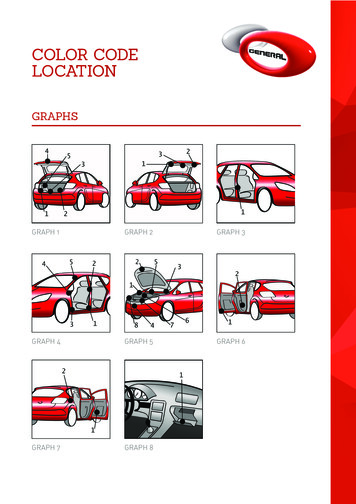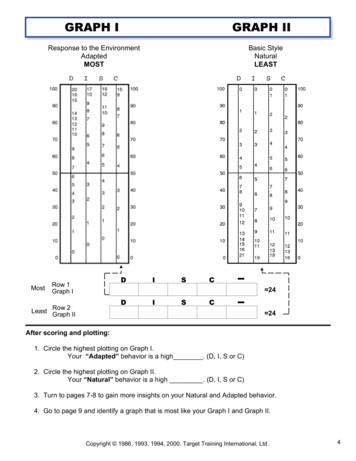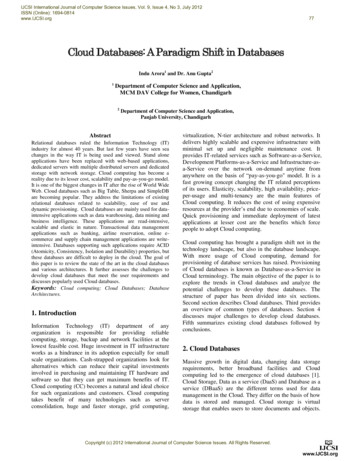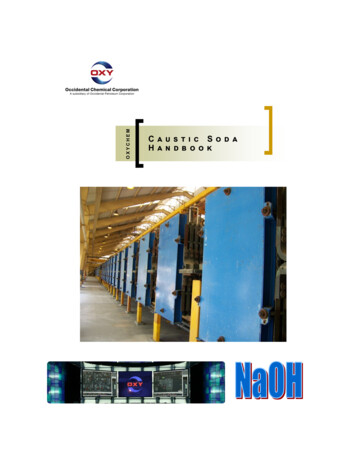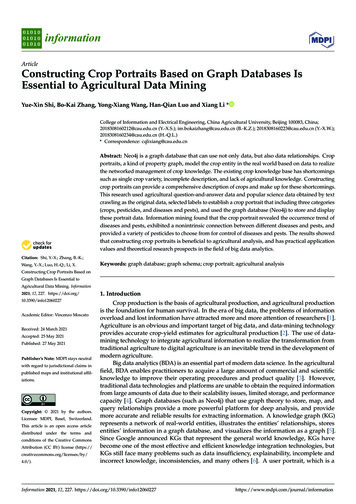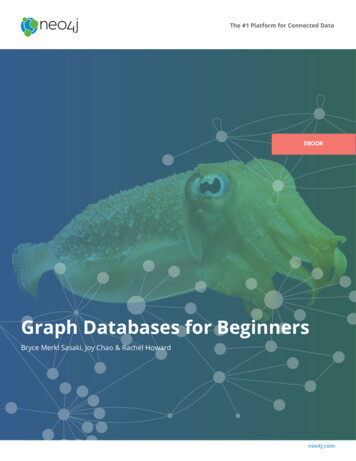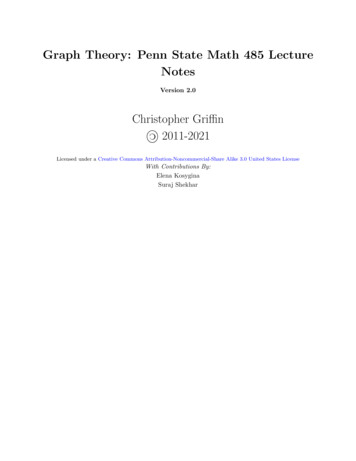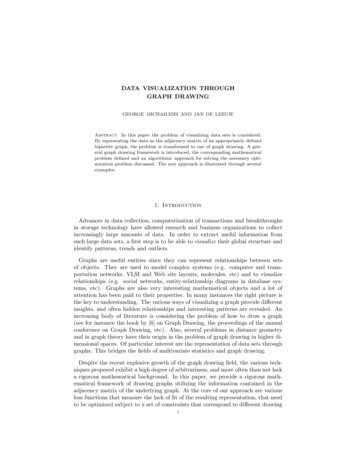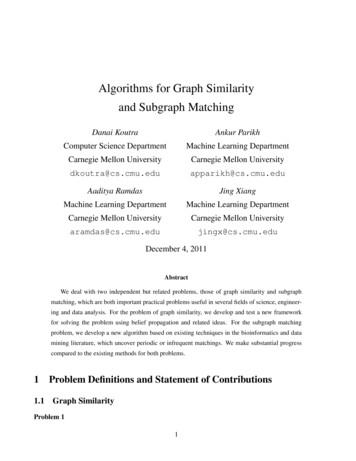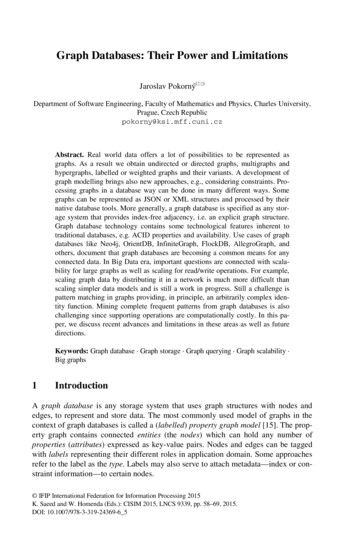
Transcription
Graph Databases: Their Power and LimitationsJaroslav Pokorný( )Department of Software Engineering, Faculty of Mathematics and Physics, Charles University,Prague, Czech Republicpokorny@ksi.mff.cuni.czAbstract. Real world data offers a lot of possibilities to be represented asgraphs. As a result we obtain undirected or directed graphs, multigraphs andhypergraphs, labelled or weighted graphs and their variants. A development ofgraph modelling brings also new approaches, e.g., considering constraints. Processing graphs in a database way can be done in many different ways. Somegraphs can be represented as JSON or XML structures and processed by theirnative database tools. More generally, a graph database is specified as any storage system that provides index-free adjacency, i.e. an explicit graph structure.Graph database technology contains some technological features inherent totraditional databases, e.g. ACID properties and availability. Use cases of graphdatabases like Neo4j, OrientDB, InfiniteGraph, FlockDB, AllegroGraph, andothers, document that graph databases are becoming a common means for anyconnected data. In Big Data era, important questions are connected with scalability for large graphs as well as scaling for read/write operations. For example,scaling graph data by distributing it in a network is much more difficult thanscaling simpler data models and is still a work in progress. Still a challenge ispattern matching in graphs providing, in principle, an arbitrarily complex identity function. Mining complete frequent patterns from graph databases is alsochallenging since supporting operations are computationally costly. In this paper, we discuss recent advances and limitations in these areas as well as futuredirections.Keywords: Graph database · Graph storage · Graph querying · Graph scalability ·Big graphs1IntroductionA graph database is any storage system that uses graph structures with nodes andedges, to represent and store data. The most commonly used model of graphs in thecontext of graph databases is called a (labelled) property graph model [15]. The property graph contains connected entities (the nodes) which can hold any number ofproperties (attributes) expressed as key-value pairs. Nodes and edges can be taggedwith labels representing their different roles in application domain. Some approachesrefer to the label as the type. Labels may also serve to attach metadata—index or constraint information—to certain nodes. IFIP International Federation for Information Processing 2015K. Saeed and W. Homenda (Eds.): CISIM 2015, LNCS 9339, pp. 58–69, 2015.DOI: 10.1007/978-3-319-24369-6 5
Graph Databases: Their Power and Limitations59Relationships provide directed, semantically relevant connections (edges) betweentwo nodes. A relationship always has a direction, a start node, and an end node. Likenodes, relationships can have any properties. Often, relationships have quantitativeproperties, such as weight, cost, distance, ratings or time interval. Properties make thenodes and edges more descriptive and practical in use. Both nodes and edges are defined by a unique identifier.As relationships are stored efficiently, two nodes can share any number or relationships of different types without sacrificing performance. Note that although they aredirected, relationships can always be navigated regardless of direction. In fact, theproperty graph model concerns data structure called in graph theory labelled anddirected attributed multigraphs.Sometimes we can meet hypergraphs in graph database software. A hypergraph isa generalization of the concept of a graph, in which the edges are substituted byhyperedges. If a regular edge connects two nodes of a graph, then a hyperedge connects an arbitrary set of nodes.Considering graphs as a special structured data, an immediate idea which arises is,how to store and process graph data in a database way. For example, we can representa graph by tables in a relational DBMS (RDBMS) and use sophisticated constructs ofSQL or Datalog to express some graph queries. Some graphs can be represented asJSON or XML structures and processed by their native database tools. A more general native solution is offered by graph databases.One of the more interesting upcoming growth areas is the use of graph databasesand graph-based analytics on large, unstructured datasets. A special attention is devoted to so-called Big Graphs, e.g. Facebook with 1 Billion nodes and 140 Billionedges, requiring special storage and processing algorithms [12].Graph databases are focused on: processing highly connected data,be flexible in usage data models behind graphs used,exceptional performances for local reads, by traversing the graph.Graph databases are often included among NoSQL databases1.We should also mention lower tools for dealing with graphs. They include frameworks, such as Google’s Pregel [8] - a system for large-scale graph processing ondistributed cluster of commodity machines, and its more advanced variant Giraph2suitable for analytical purposes. They do not use a graph database for storage. Thesesystems are particularly suitable for OLAP and offline graph analytics, i.e. they areoptimized for scanning and processing Big Graphs in batch mode. Also the notion ofa Big Analytics occurs in this context.In traditional database terminology, we should distinguish a Graph DatabaseManagement Systems (GDBMS) and a graph database. Unfortunately, the latter substitutes often the former in practice. We will also follow this imprecise aph.apache.org/
60J. PokornýThere are a lot of papers about graph models, graph databases, e.g. [7], [12], [16],and theory and practise of graph queries, e.g. [4]. Now the most popular book is ratherpractically oriented work [15]. A performance comparison of some graph databases ispresented, e.g., in [6], [9].In this paper, a lot of examples from the graph database technology will be documented on the most popular graph database Neo4j3, particularly in its version 2.2. InSection 2 we describe some basic technological features of graph databases. Section 3presents an overview of graph databases categories as well as some their representatives, i.e., some commercial products. Section 4 presents some facts concerning thepaper title and offers some research challenges. Finally, Section 5 concludes the paper.2Graph Database TechnologyAccording to other DBMS, we can distinguish a number of basic components ofgraph database technology. They include graph storage, graph querying, scalability,and transaction processing. We will discuss them in the following subsections.2.1Graph StorageAn important feature of graph databases is that provide native processing capabilities,at least a property called index-free adjacency, meaning that every node is directlylinked to its neighbour node. A database engine that utilizes index-free adjacency isone in which each node maintains direct references to its adjacent nodes; each node,therefore acts as an index of other nearby nodes, which is much cheaper than usingglobal indexes. This is appropriate for local graph queries where we need one indexlookup for starting node, and then we will traverse relationships by dereferencingphysical pointers directly. In RDBMS we would probably need joining more tablestrough foreign keys and, possibly, additional index lookups.Obviously, more advanced indexes are used. For example, it is desirable to retrievegraphs quickly from a large database via graph-based indices, e.g. path-based methods. The approach used in [17] introduces so called gIndex using frequent substructures as the basic indexing features. Unfortunately, most of these techniques areusable only for small graphs.Some graph stores offer a graph interface over non-native graph storage, such as acolumn store in the Virtuoso Universal Server4 in application for RDF data. Oftenother DBMS is used as back-end storage. For example, the graph database FlockDB5stores graph data, but it is not optimized for graph-traversal operations. Instead, it isoptimized for very large adjacency lists. FlockDB uses MySQL as the basic databasestorage system just for storing adjacency lists.345http://www.neo4j.org/ (retrieved on 9.3.2015)http://virtuoso.openlinksw.com/ (retrieved on 9.3.2015)https://github.com/twitter/flockdb (retrieved on 9.3.2015)
Graph Databases: Their Power and Limitations2.261Graph QueryingQuery capabilities are fundamental for each DBMS. Those used in graph databases,of course, come from the associated graph model [2]. The simplest type of a querypreferably uses the index-free adjacency. A node vk є V is said to be at a k-hop distance from another node v0 є V, if there exists a shortest path from v0 to vk comprisingof k edges. In practice, the basic queries are the most frequent. They include look for anode, look for the neighbours (1-hop), scan edges in several hops (layers), retrieve anattribute values, etc. Looking for a node based on its properties or through its identifier is called point querying.Retrieving an edge by id, may not be a constant time operation. For example,Titan6 will retrieve an adjacent node of the edge to be retrieved and then execute anode query to identify the edge. The former is constant time but the latter is potentially linear in the number of edges incident on the node with the same edge label.As more complex queries we meet very often subgraph and supergraph queries.They belong to rather traditional queries based on exact matching. Other typical queries include breadth-first/depth-first search, path and shortest path finding, findingcliques or dense subgraphs, finding strong connected components, etc. Algorithmsused for such complex queries need often iterative computation. This is not easy, e.g.,with the MapReduce (MR) framework used usually in NoSQL databases for BigDataprocessing. But the authors of [14] show for finding connected components that someefficient MR algorithms exist. In Big Graphs often approximate matching is needed.Allowing structural relaxation, then we talk about structural similarity queries.Inspired by the SQL language, graph databases are often equipped by a declarativequery language. Today, the most known graph declarative query language is Cypherworking with Neo4j database. Cypher commands are loosely based on SQL syntaxand are targeted at ad hoc queries of the graph data. A rather procedural graph language is the traversal language Gremlin7.The most distinctive output for a graph query is another graph, which is ordinarilya transformation, a selection or a projection of the original graph stored in the database. This implies that graph visualization is strongly tied to the graph querying [13].2.3ScalabilitySharding (or graph partitioning) is crucial to making graphs scale. Scaling graph databy distributing it across multiple machines is much more difficult than scaling thesimpler data in other NoSQL databases, but it is possible. The reason is the very nature way the graph data is connected. When distributing a graph, we want to avoidhaving relationships that span machines as much as possible; this is called the minimum point-cut problem. But what looks like a good distribution one moment may nolonger be optimal a few seconds later. Typically, graph partition problems fall underthe category of NP-hard problems. Scaling is usually connected with three things:67http://thinkaurelius.github.io/titan/ (retrieved on 9.3.2015)http://gremlindocs.com/
62 J. Pokornýscaling for large datasets,scaling for read performance,and scaling for write performance.In practice, the former is most often discussed. Today, it is not problem in graphdatabases area. For example, Neo4j currently has an arbitrary upper limit on the sizeof the graph on the order of 1010. This is enough to support most of real-world graphs,including a Neo4j deployment that has now more than half of Facebook's social graphin one Neo4j cluster.Scaling for reads usually presents no problem. For example, Neo4j has historicallyfocused on read performance. In master-slave regime read operations can be donelocally on each slave. To improve scalability in highly concurrent workloads, Neo4juses two levels of caching.Scaling for writes can be accomplished by scaling vertically, but at some point, forvery heavy write loads, it requires the ability to distribute the data across multiplemachines. This is the real challenge. For example, Titan is a highly scalable OLTPgraph database system optimized for thousands of users concurrently accessing andupdating one Big Graph.2.4Transaction ProcessingAs in any other DBMS, there are three generic use cases for graphs: CRUD (create, read, update, delete) applications,query processing - reporting, data warehousing, and real-time analytics,batch mode analytics or data discovery.Graph databases are often optimized and focused on one or more of these uses.Particularly, the first two uses are focused on transactions processing, i.e. OLTP databases. When dealing with many concurrent transactions, the nature of the graph datastructure helps spread the transactional overhead across the graph. As the graph growstransactional conflicts typically falls away, i.e. extending the graph tends to the morethroughputs. But not all graph databases are fully ACID. However, the variant basedon the BASE properties often considered in the context of NoSQL databases is nottoo appropriate for graphs.In general, distributed graph processing requires the application of appropriate partitioning and replication strategies such as to maximise the locality of the processing,i.e., minimise the need to ship data between different network nodes.For example, Neo4j uses master-slave replication, i.e. one machine is designated asthe master and the others as slaves. In Neo4j, all writes directed towards any machineare passed through the master, which in turn ships updates to the slaves when polled.If the master fails, the cluster automatically elects a new master.Neo4j requires a quorum in order to serve write load. It means that a strict majorityof the servers in the cluster need to be online in order for the cluster to accept writeoperations. Otherwise, the cluster will degrade into read-only operation until a quorum can be established. Emphasize, that today’s graph databases do not have the same
Graph Databases: Their Power and Limitations63level of write throughput as other types of NoSQL databases. This is a consequence ofmaster-slave clustering and proper ACID transactions.Some more complex architectures occur in the world of graph databases. Typically, a simple database is used to absorb load, and then feed the data into a graph database for refinement and analysis. The architecture Neo4j 2.2 contains even a bulkloader which operates at throughput of million records per second.3Categories of Graph DatabasesThere are a lot of graph databases. The well-maintained and structured Web site 8included 20 products belonging among GDBMSs in 2011. The development of graphdatabases until 2011 is described in [1]. Wikipedia9 describes 45 such tools. One halfof them are ACID compliant.We distinguish general purpose GDBMs, like Neo4j, InfiniteGraph10, Sparksee11,Titan, GraphBase 12 , and Trinity 13 , and special ones, e.g. the Web graph databaseInfoGrid14 and FlockDB, or multimodel databases such as document-oriented databases enabling traversing between documents. For example, OrientDB 15 brings together the power of graphs and the flexibility of documents into one scalable databaseeven with an SQL layer. HyperGraphDB16 stores not only graphs but also hypergraphstructures. All the graph information is stored in the form of key-value pairs.An interesting question is which graph databases are most popular today. In June2015, the web page DB-Engines Ranking of GDBMS17 considering 17 graph products presented Neo4j, OrientDB, and Titan on the first three places. GDBMSSparksee is on the 6th place.In Section 3.1 we present two typical representatives of the general purpose category. From those special ones, more attention will be devoted to RDF triplestores inSection 3.2. The framework Pregel is explained in Section 3.3.3.1General Graph Purpose Databases - ExamplesWe describe shortly two successful graph GDBMSs - Neo4j and Sparksee - in somedetail. In both GDBMSs a graph is a labelled directed attributed multigraph, whereedges can be either directed or undirected.8http://nosql-database.org/ (retrieved on 9.3.2015)http://en.wikipedia.org/wiki/Graph database#cite 1 (retrieved on ph#.U8O yXnm9I0 (retrieved on see (retrieved on 9.3.2015)12http://graphbase.net/ (retrieved on jects/trinity/ (retrieved on 9.3.2015)14http://infogrid.org/trac/ (retrieved on 9.3.2015)15http://www.orientechnologies.com/ (retrieved on p://db-engines.com/en/ranking/graph dbms (retrieved on 12.6.2015)
64J. PokornýExample 1: Neo4jNeo4j (now in version 2.2) is the world’s leading GDBMS. It is an open-source, highly scalable, robust (fully ACID compliant) native graph database.Neo4j stores data as nodes and relationships. Both nodes and relationships can holdproperties in a key-value form. Values can be either a primitive or an array of oneprimitive type. Nodes are often used to represent entities, but depending on the domain the relationships may be used for that purpose as well. The nodes and edgeshave internal unique identifiers that can be used for the data search. Nodes cannotreference themselves directly [5]. The semantics can be expressed by adding directedrelationships between nodesGraph processing in Neo4j entails mostly random data access which can be unsuitable for Big Graphs. Graphs that cannot fit into main memory may require more diskaccesses, which significantly influences graph processing. Big Graphs similarly toother Big Data collections must be partitioned over multiple machines to achievescalable processing (see Section 2.3).Example 2: SparkseeIn addition to the basic graph model, Sparksee also introduces the notion of a virtualedge that connects nodes having the same value for a given attribute. These edges arenot materialized. A Sparksee graph is stored in a single file; values and identifiers aremapped by mapping functions into B -trees. Bitmaps are used to store nodes andedges of a certain type.The architecture of Sparksee includes the core, that manages and queries the graphstructures, then an API layer to provide an application programming interface, and thehigher layer applications, to extend the core capabilities and to visualize and browsethe results. To speed up the different graph queries and other graph operations,Sparksee offers these index types: attributes,unique attributes,edges to index their neighbours, andindices on neighbours.Sparksee implements a number of graph algorithms, e.g. shortest path, depth-firstsearching, finding strong connected components.3.2TriplestoresSome graph-oriented products are intended for special graph applications, mostlyRDF data expressed in the form of subject (S) - predicate (P) – object (O). RDFgraphs can be viewed as a special kind of a property graph. At the logical level, anRDF graph is then represented as one table. For example, AllegroGraph18 workswith RDF graphs. BrightStarDB19, Bigdata20 and SparkleDB21 (formerly known as1819http://franz.com/agraph/ (retrieved on 9.3.2015)http://brightstardb.com/ (retrieved on 9.3.2015)
Graph Databases: Their Power and Limitations65Meronymy) serve for similar purposes. These triple stores employ intelligent datamanagement solutions which combine full text search with graph analytics and logicalreasoning to produce deeper results. Sometimes, quad stores are used holding a fourthattribute - the graph name (N) corresponding normally with the namespace of theontology. AllegroGraph deals even with quints (S, P, O, N, ID), the ID can be used toattach metadata to a triple.Now, GraphDB 22 is the world’s leading RDF triple store that can perform semantic inferring at scale allowing users to create new semantic facts from existingfacts. GraphDB is built on OWL (Ontology Web Language). It uses ontologies thatallow the repository to automatically reason about the data. AlegroGraph also supports reasoning and ontology modelling.However, existing triple store technologies are not yet suitable for storing trulylarge data sets efficiently. According to the W3C Wiki, AllegroGraph leads the largest deployment with loading and querying 1 Trillion triples. The load operation alonetook about 338 hours.We remind also that triple stores create only a subcategory of graph databases. Rather a hybrid solution is represented by Virtuoso Universal Server23. Its functionalitycovers not only processing RDF data, but also relations, XML, text, and others.A list of requirements often required by customers considering a triple store is introduced in [10]: inferring,integration with text mining pipelines,scalability,extensibility,enterprise resilience,data integration and identity resolution,semantics in the cloud,semantic expertise.3.3Pregel and GiraphPregel and Giraph are systems for large-scale graph processing. They provide a faulttolerant framework for the execution of graph algorithms in parallel over many machines. Giraph utilizes Apache MR framework implementation to process graphs.A significant approach to the design, analysis and implementation of parallel algorithms, hardware and software in Pregel is now the Bulk Synchronous Processing(BSP) model. BSP offers architecture independence and very high performance ofparallel algorithms on top of multiple computers connected by a communication network.20212223http://www.systap.com/ (retrieved on 9.3.2015)https://www.sparkledb.net/ (retrieved on -graphdb/ (retrieved on 9.3.2015)http://virtuoso.openlinksw.com/ (retrieved on 9.3.2015)
66J. PokornýBSP is a powerful generalization of MR. A subclass of BSP algorithms can be efficiently implemented in MR [11]. BSP is superfast on standard commodity hardware,orders of magnitude faster than the MR alone. It is an easy parallel programmingmodel to learn, it has a cost model that makes it simple to design, analyse, and optimize massively parallel algorithms. It can be considered as a strong candidate to bethe programming model for parallel computing and Big Data in the next years. Forexample, Google is already moving in its internal infrastructure from MR toBSP/Pregel.4Limitations of Graphs DatabasesDespite of the long-term research and practice in this area, there are many importantand hard problems that remain open in graph data management. They have influenceon functionality restrictions of graph databases (Section 4.1). Others are specificallyrelated to Big Analytics (Section 4.2). Challenges concerning some specific problems of graph database technology are summarized in Section 4.3.4.1Functionality RestrictionsDeclarative querying: Most commercial graph databases cannot be queried using adeclarative language. Only few vendors offer a declarative query interface. This implies also a lack of query optimization abilities.Data partitioning: Most graph databases do not include the functionality to partitionand distribute data in a computer network. This is essential for supporting horizontalscalability, too. It is difficult to partition a graph in a way that would not result inmost queries having to access multiple partitions.Vectored operations: They support a procedure which sequentially writes data frommultiple buffers to a single data stream or reads data from a data stream to multiplebuffers. Horizontally scaled NoSQL databases support this type of data access. Itseems that it is not the case in graph databases today.Model restrictions: Possibilities of data schema and constraints definitions are restricted in graph databases. Therefore, data inconsistencies can quickly reduce theirusefulness. Often the graph model itself is restricted. Let us recall, e.g., Neo4j nodescannot reference themselves directly. There might be real world cases where selfreference is required.Querying restrictions: For example, FlockDB overcomes the difficulty of horizontalscaling the graph by limiting the complexity of graph traversal. In particular,FlockDB does not allow multi-hop graph walks, so it cannot do a full "transitiveclosure". However, FlockDB enables very fast and scalable processing of 1-hopqueries.
Graph Databases: Their Power and Limitations4.267Big Analytics RequirementsGraph extraction: A question is how to efficiently extract a graph, or a collection ofgraphs, from non-graph data stores. Most graph analytics systems assume that thegraph is provided explicitly. However, in many cases, the graph may have to be constructed by joining and combining information from different resources which are notnecessarily graphical. Even if the data is stored in a graph database, often we onlyneed to load a set of subgraphs of that database graph for further analysis.High cost of some queries: Most real-world graphs are highly dynamic and often generate large volumes of data at a very rapid rate. One challenge here is how to store thehistorical trace compactly while still enabling efficient execution of point queries andglobal or neighbourhood-centric analysis tasks. Key differences from temporalDBMSs developed in the past are the scale of data, focus on distributed and inmemory environments, and the need to support global analytics. The last task usuallyrequires loading entire historical snapshots into memory.Real time processing: As noted, graph data discovery takes place essentially in batchenvironments, e.g., in Giraph. Some products aimed at data discovery and complexanalytics that will operate in real-time. An example is uRIKA24 – a Big Data Appliance for Graph Analytics. It uses in-memory technology and multithreaded processorto support non-batch operations on RDF triples.Graph algorithms: More complex graph algorithms are needed in practice. The idealgraph database should understand analytic queries that go beyond k-hop queries forsmall k. Authors of [9] did a performance comparison of 12 open source graph databases using four fundamental graph algorithms (e.g. simple source shortest path problem and Page Rank) on networks containing up to 256 million edges. Surprisingly, themost popular graph databases have reached the worst results in these tests. Currentgraph databases (like relational databases) tend to prioritize low latency query execution over high-throughput data analytics.Parallelisation: In the context of Big Graphs there is a need for parallelisation ofgraph data processing algorithms when the data is too big to handle on one server.There is a need to understand the performance impact on graph data processing algorithms when the data does not all fit into the memory available and to design algorithms explicitly for these scenarios.Heterogeneous and uncertain graph data: There is a need to find automated methodsof handling the heterogeneity, incompleteness and inconsistency between differentBig Graph data sets that need to be semantically integrated in order to be effectivelyqueried or urika-gd
684.3J. PokornýOther ChallengesOther challenges in the development of graph databases include:Design of graph databases: Similarly to traditional databases, some attempts to develop design models and tools occur in last time. In [3], the authors propose a modeldriven, system-independent methodology for the design of graph databases startingfrom ER-model conceptual schema.Need for a benchmark: Querying graph data can significantly depend on graph properties. The benchmarks built, e.g., for RDF data are mostly focused on scaling and noton querying. Also benchmarks covering a variety of graph analysis tasks would helptowards evaluating and comparing the expressive power and the performance of different graph databases and frameworks.Developing heuristics for some hard graph problems: For example, partitioning oflarge-scale dynamic graph data for efficient distributed processing belongs amongthese problems, given that the classical graph partitioning problem is NP-hard.Graph pattern matching: New semantics and algorithms for graph pattern matchingover distributed graphs are in development, given that the classical subgraph isomorphism problem is NP-complete.Compressing graphs: Compressing graphs for matching without decompression ispossible. Combining parallelism with compressing or partitioning is also very interesting.Integration of graph data: In the context of Big Data, query formulation and evaluation techniques to assist users querying heterogeneous graph data are needed.Visualization: Improvement of human-data interaction is fundamental, particularly avisualization of large-scale graph data, and of query and analysis results.Graph streams processing: Developing algorithms for processing Big Graph datastreams with goal to compute properties of a graph without storing the entire graph.5ConclusionsGraph databases are becoming mainstream. As data becomes connected in a morecomplicated way and as the technology of graph databases matures, their use willincrease. New application areas occur, e.g. the Internet of Things, or rather Internet ofConnected Things. Comparing to traditional RDBMS, there is a difficulty for potential users to identify the particular types of use case for which each product is mostsuitable. Performance varies greatly across different GDBMSs depending upon thesize of the graph and how well-optimized a given tool is for a particular task. It seemsthat especially for Big Graphs and Big Analytics a lot of previous results and des
A graph database is any storage system that uses graph structures with nodes and edges, to represent and store data. The most commonly used model of graphs in the . This implies that graph visualization is strongly tied to the graph querying [13]. 2.3 Scalability Sharding (or graph partitioning) is crucial to making graphs scale. Scaling .
